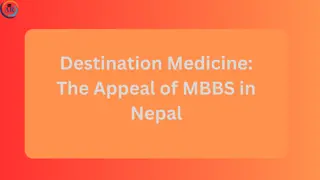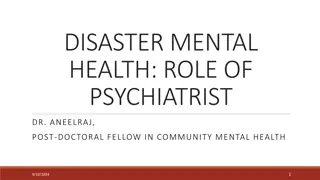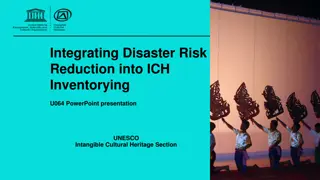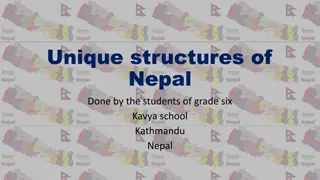Building Disaster Resilience: Essential Characteristics of Nepal's Communities
Explore the vital components of disaster resilience in Nepalese communities, including organizational structures, government partnerships, risk reduction strategies, and coordination mechanisms. Discover how key stakeholders collaborate to enhance school and hospital safety, emergency response capacity, flood management, and community-based disaster risk reduction initiatives.
- Disaster resilience
- Nepal communities
- Risk reduction strategies
- Government partnerships
- Emergency response
Download Presentation

Please find below an Image/Link to download the presentation.
The content on the website is provided AS IS for your information and personal use only. It may not be sold, licensed, or shared on other websites without obtaining consent from the author. Download presentation by click this link. If you encounter any issues during the download, it is possible that the publisher has removed the file from their server.
E N D
Presentation Transcript
Nine Minimum Characteristics of a Disaster Resilient Community in Nepal Krishna Kumar K.C. Focal Point CBDRM Coordination Mechanism IFRC
Structure Government NRCS Donors INGOs / AIN Academics Flagship 4 Other interested parties NGOs / CBOs F1: School Safety F1: Hospital Safety F3: Flood F2: Emergency Prep & Response Management Rivers F5: Policy & Institutional Support NRRC
Nepal Risk Reduction Consortium National Strategy for Disaster Risk Management (2009). Key framework for DM activities in Nepal. NRRC formed to address five derived priorities: School and hospital safety (MoE, MoHP, ADB, UNICEF, WHO) Emergency preparedness and response capacity (MoHA, IFRC) Flood management in river basins (Ministry of Irrigation, World Bank) Integrated Community Based Disaster Risk Reduction/Management(BDRR (MoFALD, IFRC) Policy/institutional support for disaster risk management (MoHA, UNDP) 1. 2. 3. 4. 5.
Coordination Mechanisms Chair: Ministry of Home Affairs Focal Ministries of the Government of Nepal Official Consortium partners Nepal Risk Reduction Consortium Steering Committee & Secretariat Chair: Ministry of Federal Affairs and Local Development Secretariat: IFRC Members: INGO, Donors, Government, NRCS, DM coordination body Flagship 4 Advisory Committee (Flagship 4 Coordinator) Flagship 4 Consultation Group Open to all interested parties Task Groups formed on technical issues as needed Flagship 4 Web-Based Information Platform
9 Minimum Characteristics of a Resilient Community
1. Organisational base at rural/municipality / ward and community level A functional organizational base at rural/ municipality/ ward and community level for the implementation and sustainability of disaster risk reduction (DRR), which addresses the issues of protection, social inclusion (including gender balance), community ownership and participation and follows DRR initiatives.
2. Access to Disaster Risk Reduction (DRR) information Coordination mechanisms and partnerships to enable access to DRR information involving local, district and national level government structures, civil society organizations, private sector and vulnerable groups, including linkages with key institutions such as schools and hospitals.
3. Multi-hazard risk and capacity assessments Ongoing, systematic, participatory, multi-hazard risk and capacity assessments which enable the monitoring and evaluation of DRR at municipality and community level and which link into district and national monitoring and evaluation systems.
4. Community preparedness / response teams This involves community teams that are trained and equipped to provide hazard warning and evacuation information, light search and rescue and basic first aid.
5. Disaster Risk Reduction / Management plan at Village Development Committee / municipality level A plan at the local level which meets the Flagship 4 minimum requirements listed and is regularly updated, implemented and tested.
7. Access to community-managed resources Access to community-managed resources such as human and materials at municipality/ ward levels for DRR initiatives.
6. Disaster Risk Reduction (DRR) Funds Funds accessible to communities for priority disaster risk reduction activities which are available at municipality / ward level and/or through community resource mobilization efforts.
8. Local level risk / vulnerability reduction measures Municipality / ward level initiatives on identification, prioritization and application of local level risk / vulnerability reduction measures.
9. Community based early warning systems Inclusive, community based early warning systems that are integrated with municipality / ward, district, regional and national early warning systems.























